
At the recent launch of Wrath of the Lich King in Anaheim, CA the other evening, we were given the chance to interview Lead Game Designer Tom Chilton. Tom works with all sorts of game-specifics such as balancing, items, the mail system, and a ton more. Let’s just say he is a very busy guy and we would like to thank him for taking the time to meet with us at such a frenetic event.
GS: How would you describe your experience in developing Wrath over the last couple years?
TC: Well, it started before Burning Crusade shipped actually, we first started our ‘concepting’ and, I remember thinking at the time ‘Oh God, we’re already starting on another expansion when we’re still trying to get this one finished.’ At the same time, it was real exciting to work on because right from the start that there was something special about Lich King. The way the story plays out…the way the features came together, all the new zones, and the Death Knight. I think there was alot of excitement in that we felt this could be even better than Burning Crusade. Overall: Fun, exciting!
See the full interview after the break!
GS: How did the Blizzard infrastructure hold up in the transition to Lich King? Were there any major upgrades that needed to be done?
TC: Well, we did a lot of work on our tools, internally, so that designers would have more power over how to create quests and do new things. For example, our vehicle technology where we knew that we wanted vehicles not only as a feature in pvp but also pve and we also wanted to expand that and use it to do all kinds of new quests that we were never able to do before. One of the things that we have always had in our minds is that while there has to be some ‘kill ten of this’ and ‘collect 5 of that’ kind of quests, we don’t want that to feel like that’s all there is. We really want to make sure that Lich King feels like more than that and so we wanted to make sure there were several new types of quests that we never had gotten to do before.
GS: You have a lot of history in game development. Are there any other genre of games you would like to work on in the future?
TC: For the most part I am focused on WoW. I mean we have other projects in development like Diablo III and an unannounced project that I contribute to, so its really fun to mix it up a bit and put in time on those games also. My biggest passion is with role-playing games but in the past I have been an avid RTS gamer and shooter gamer. I really like games in all forms but for now I can see myself working on WoW and RPGs in the general sense for a while.
GS: And whats the name of the unannounced project (I had to try)?
TC: [laughs] The unannounced project.
GS: When you first began working on World of Warcraft, did you have a sense that it would become as popular as it has?
TC: No, to be honest, I really didn’t. I felt like this was going to be the best MMO out there and I kind of figured that we would do well. I would never have guessed a million players, let alone the 11 million players we have now. Its pretty mind blowing.
GS: What is the current status of in-game player housing?
TC: You know, its a feature we have talked about adding for years before WoW even came out and its always been something where we feel like there are clearly a lot of other games that have done it, but we don’t feel like any of them have done it to the quality we would want to do it…We would want it to feel that it was really well-built into the game but, unfortunately, that means it is a huge task and its something that we really haven’t been able to get to at this point.
GS: How did the concept of in-game motorcycle mounts come about?
TC: [laughs] Well, let’s see. The mechanohog is something that one of our concept guys just kind of drew up and we thought it would be awesome…Its just one of those things where we had to do it. It appeals to our sense of humor and we have done mechanostryders for the Gnomes and we look at things like that which are kind of quirky and off to the side and not exactly what you would expect our of a medieval fantasy universe and try to make sure we find a way to make it looks like it still fits…
GS: Many Paladin-players are upset about the recent nerfing of their protection abilities in order to ‘fix’ the over-powered retribution ones. Do you have anything you would like to tell them?
TC: Well, we definitely still feel like the Paladins are very competitive tanks. We have been really pressed with Lich King to make sure that all of the tanking classes remain viable in all their different specs. Its definitely something that is very important to us to make sure that every tank out there feels like they can generate enough threat, keep the agro, deal respectable damage, that they have the mitigation they need to take on high-end bosses, and we still feel like Paladins are fitting that. Anytime we start to hear that kind of feedback we start to do our own investigations to find out if what they are saying is true or is it some misconception of where they use to be when they were over-powered, that kind of thing. So, we definitely will be doing our own investigations on that and if it proves to be true we will make changes.
GS: Are there any plans to upgrade the visuals of the various Druid forms in the game?
TC: We actually have plans to upgrade the forms, its actually something we talked about back at the Worldwide Invitational. Unfortunately, it didn’t get in at the launch of Lich King but we do have artists which are actively working on it…One thing that we were always leary on in the past and actually caused us to delay on it longer than we would have is that we don’t generally have good experience with changing the way something looks out from under a player. So, we have to be very careful in going down that road and, in this case, what we are looking into doing is providing options for how to look rather than kind of forcing a new model on them…Believe it or not, there are plenty of Druids our there who are perfectly happy with the way they look and we don’t want to upset all of them in the process…
We would like to thank Tom Chilton again as well as the rest of the Blizzard staff on-hand at the launch event who made this interview possible.

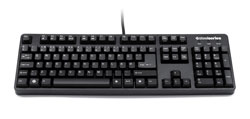 SteelSeries has long been known as a developer of high-end gaming peripherals and their ‘7G’ gaming keyboards keeps to this tradition well. It is the most solid and well-made keyboard I have ever had the pleasure of using.
SteelSeries has long been known as a developer of high-end gaming peripherals and their ‘7G’ gaming keyboards keeps to this tradition well. It is the most solid and well-made keyboard I have ever had the pleasure of using.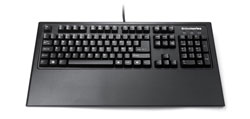 However, it is an all-metal design and can chafe if used for long periods of time. While SteelSeries has told us this design decision was made for durability purposes (gel rests can puncture and decay), and this makes sense, we recommend you put a soft barrier between the rest’s metal and your wrists for your own comfort.
However, it is an all-metal design and can chafe if used for long periods of time. While SteelSeries has told us this design decision was made for durability purposes (gel rests can puncture and decay), and this makes sense, we recommend you put a soft barrier between the rest’s metal and your wrists for your own comfort.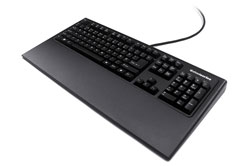 This can be seen pretty much anytime your USB ports ‘freeze up’. While the PC processes what is going on, if you had a PS/2 keyboard installed it would still be able to pass on your key presses. Also, this allows the 7G to be used during your PC’s booting period where a USB keyboard might not have been detected yet. We would like to thank Mr. Rom for his helpful answers.
This can be seen pretty much anytime your USB ports ‘freeze up’. While the PC processes what is going on, if you had a PS/2 keyboard installed it would still be able to pass on your key presses. Also, this allows the 7G to be used during your PC’s booting period where a USB keyboard might not have been detected yet. We would like to thank Mr. Rom for his helpful answers.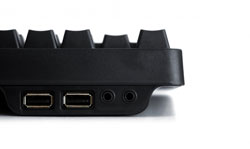 Conclusion: If you are looking for the best ‘functional’ gaming keyboard possible, the SteelSeries 7G gaming keyboard is exceptional and well-worth its $150 dollar price point in that it very well could be the last keyboard you need to buy until the apocalypse, maybe. Even then, the thing might just hold-up fine. Unfortunately, nuclear testing was not part of our review regiment. Also, we cannot say what the value of the beast will be in bottle caps. Sorry, we have been playing Fallout 3 too much. The biggest complaint we can find about this keyboard is the lack of back-lighting. If you can get over not having the ‘bells and whistles’ and are able to afford it, the 7G is easily the keyboard for you.
Conclusion: If you are looking for the best ‘functional’ gaming keyboard possible, the SteelSeries 7G gaming keyboard is exceptional and well-worth its $150 dollar price point in that it very well could be the last keyboard you need to buy until the apocalypse, maybe. Even then, the thing might just hold-up fine. Unfortunately, nuclear testing was not part of our review regiment. Also, we cannot say what the value of the beast will be in bottle caps. Sorry, we have been playing Fallout 3 too much. The biggest complaint we can find about this keyboard is the lack of back-lighting. If you can get over not having the ‘bells and whistles’ and are able to afford it, the 7G is easily the keyboard for you.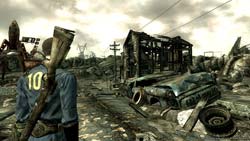 ‘War. War never changes’. It is with these words that began one of the greatest role-playing games ever made (of course I mean Fallout). The RPG and its sequel are renown for their tongue-in-cheek humor, stylistic design, and isometric gameplay. When we heard Bethsoft was taking the reigns on Fallout 3, and that it would be a first-person game, forums around the ‘net lit up with flame wars on the subject. Die-hards of the series naturally had a worry that by bringing the series into the first-person, Bethsoft would be taking away an aspect which made the previous games undeniably ‘Fallout’. We are pleased to say, however, that this worry has proven itself false. This is a Fallout game.
‘War. War never changes’. It is with these words that began one of the greatest role-playing games ever made (of course I mean Fallout). The RPG and its sequel are renown for their tongue-in-cheek humor, stylistic design, and isometric gameplay. When we heard Bethsoft was taking the reigns on Fallout 3, and that it would be a first-person game, forums around the ‘net lit up with flame wars on the subject. Die-hards of the series naturally had a worry that by bringing the series into the first-person, Bethsoft would be taking away an aspect which made the previous games undeniably ‘Fallout’. We are pleased to say, however, that this worry has proven itself false. This is a Fallout game.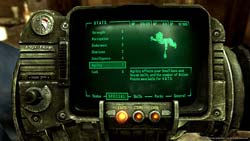 Thankfully, if you can get past the sense of sadness for the human race as a whole, you will find a gigantic amount of things to do and see. Quests can be found in abundance and it is very doubtful you will finish everything in one play through. In fact, your character’s level is capped at 20, making it very likely you will play the game over again at least a few times, trying different character builds. Bethsoft has stated numerous times that they wanted to increase the re-playability of the game immensely and they have succeeded in this feat. Of course, the low level cap is also probably some foreshadowing that forthcoming DLC will raise it somewhat for added quests, etc.
Thankfully, if you can get past the sense of sadness for the human race as a whole, you will find a gigantic amount of things to do and see. Quests can be found in abundance and it is very doubtful you will finish everything in one play through. In fact, your character’s level is capped at 20, making it very likely you will play the game over again at least a few times, trying different character builds. Bethsoft has stated numerous times that they wanted to increase the re-playability of the game immensely and they have succeeded in this feat. Of course, the low level cap is also probably some foreshadowing that forthcoming DLC will raise it somewhat for added quests, etc. When you are ready, simple click accept and the fun begins. The results of your stacked actions are shown in a cinematic, bullet-time, method with various camera angles and the like. The V.A.T.S. combat system can lead to some VERY cool-looking combat. For instance, using my Chinese pistol (which makes me feel a bit like Han Solo) I initiated combat with a raider. I queue up V.A.T.S. and assign two shots to the body, one to the left leg, and the last to the head and then click accept. The following ‘cut-scene’ (and I use the term loosely as it is all done in-game) blew me away and was completely unexpected. My two shots to the body blew the raider back a bit, obviously wounding him deeply. He turned around and began to run in an attempt to escape my wrath but he was not fast enough. My shot to his leg crippled him, sending him to the ground in a heap. My last shot finished him off with spectacular gore and violence. This kind of scenario does not happen all the time. However, it happens enough to make you want to continue using V.A.T.S. whenever possible. Using this mode drains you of action points (or ‘AP’) which must be recharged in real-time mode. This is just another example of the great lengths Bethsoft took in making Fallout 3 accessible to new gamers as well as fans of the original RPGs.
When you are ready, simple click accept and the fun begins. The results of your stacked actions are shown in a cinematic, bullet-time, method with various camera angles and the like. The V.A.T.S. combat system can lead to some VERY cool-looking combat. For instance, using my Chinese pistol (which makes me feel a bit like Han Solo) I initiated combat with a raider. I queue up V.A.T.S. and assign two shots to the body, one to the left leg, and the last to the head and then click accept. The following ‘cut-scene’ (and I use the term loosely as it is all done in-game) blew me away and was completely unexpected. My two shots to the body blew the raider back a bit, obviously wounding him deeply. He turned around and began to run in an attempt to escape my wrath but he was not fast enough. My shot to his leg crippled him, sending him to the ground in a heap. My last shot finished him off with spectacular gore and violence. This kind of scenario does not happen all the time. However, it happens enough to make you want to continue using V.A.T.S. whenever possible. Using this mode drains you of action points (or ‘AP’) which must be recharged in real-time mode. This is just another example of the great lengths Bethsoft took in making Fallout 3 accessible to new gamers as well as fans of the original RPGs. A new feature in Fallout 3 that we have not seen before in the series is the ability to own your own home. In certain areas and by accomplishing certain tasks, it is possible to own your own residence. This provides you with a free place to rest and heal up as well as the ability to customize it with house-specific items like jukeboxes, first-aid stations, and more.
A new feature in Fallout 3 that we have not seen before in the series is the ability to own your own home. In certain areas and by accomplishing certain tasks, it is possible to own your own residence. This provides you with a free place to rest and heal up as well as the ability to customize it with house-specific items like jukeboxes, first-aid stations, and more.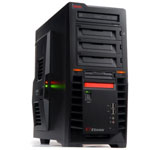 GMC, a Korean company, has been making its mark on the North American PC case market for a short time now. They usually offer cases with plenty of cool features and eye-popping designs. Their first gamer-specific enclosure, the X7 ‘X-Station’ is no different.
GMC, a Korean company, has been making its mark on the North American PC case market for a short time now. They usually offer cases with plenty of cool features and eye-popping designs. Their first gamer-specific enclosure, the X7 ‘X-Station’ is no different.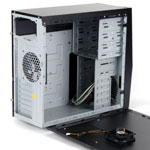 The X7 is designed with militaristic-looking black lines which lend themselves well to the gamer-centric motif. It actually reminds me of something you would see in Batman’s ‘Tumbler Batmobile’. The bezel features a couple of cool orange power lights as well as four USB 2.0 ports, power button, and reset button. We would like to have seen an eSATA and/or FireWire port on the front, but we digress. The X-7 also features a backlit LCD display which shows the case temperature and fan speed.
The X7 is designed with militaristic-looking black lines which lend themselves well to the gamer-centric motif. It actually reminds me of something you would see in Batman’s ‘Tumbler Batmobile’. The bezel features a couple of cool orange power lights as well as four USB 2.0 ports, power button, and reset button. We would like to have seen an eSATA and/or FireWire port on the front, but we digress. The X-7 also features a backlit LCD display which shows the case temperature and fan speed. 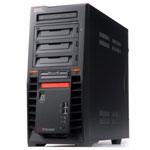 Inside the case, there is just enough room to accommodate a gtx 280 video card, making cabling somewhat of a challenge. This is not out of the ordinary though, as most cases have issues in this department.
Inside the case, there is just enough room to accommodate a gtx 280 video card, making cabling somewhat of a challenge. This is not out of the ordinary though, as most cases have issues in this department.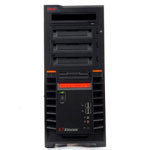 The case allows for up to four 3.5” drives to be installed, right behind the 80mm forward area fan to promote hard disk cooling.
The case allows for up to four 3.5” drives to be installed, right behind the 80mm forward area fan to promote hard disk cooling.


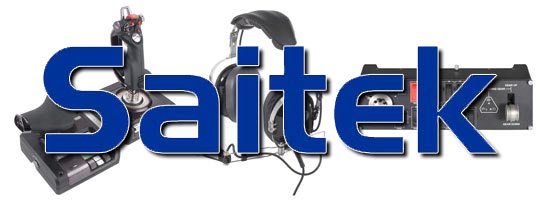
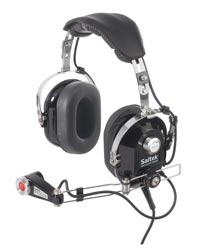 Q) What kind of a design process is used in developing new Pro-Flight peripherals? How much are real pilots used in this process?
Q) What kind of a design process is used in developing new Pro-Flight peripherals? How much are real pilots used in this process?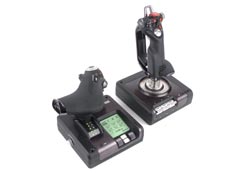 Q) How would you describe the flight simulation market currently???
Q) How would you describe the flight simulation market currently???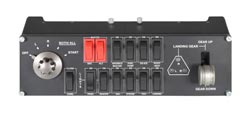 Q) And last, is there anything you would like our readers to know about that we have not covered here???
Q) And last, is there anything you would like our readers to know about that we have not covered here???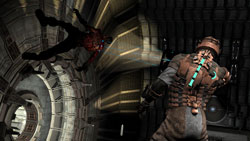 I had a vague idea of what to expect from seeing it played briefly at this year’s E3 Media and Business Summit. At least, I thought I did. I guess seeing it played in a brightly lit convention room flooded with fellow gamers is a lot different than sitting down in a darkened room to play it by myself.
I had a vague idea of what to expect from seeing it played briefly at this year’s E3 Media and Business Summit. At least, I thought I did. I guess seeing it played in a brightly lit convention room flooded with fellow gamers is a lot different than sitting down in a darkened room to play it by myself. The design of the necromorphs is perfect. They look to be inspired by Rob Bottin’s and Lance Anderson’s work in John Carpenter’s 1982 film, The Thing. This fact alone did not bode well for me, as growing up The Thing was the only movie to ever really scare me. The idea of something using your own body for its grotesque purposes just creeped me out, and still does. Killing these abominations is a matter of tactics, just not spraying and praying. You have to dismember them first by blowing off their limbs/tentacles. This will usually kill the creature. If you try shooting it in the torso or head on the other hand, you will usually just piss it off. Trust me, don’t piss them off if you can help it.
The design of the necromorphs is perfect. They look to be inspired by Rob Bottin’s and Lance Anderson’s work in John Carpenter’s 1982 film, The Thing. This fact alone did not bode well for me, as growing up The Thing was the only movie to ever really scare me. The idea of something using your own body for its grotesque purposes just creeped me out, and still does. Killing these abominations is a matter of tactics, just not spraying and praying. You have to dismember them first by blowing off their limbs/tentacles. This will usually kill the creature. If you try shooting it in the torso or head on the other hand, you will usually just piss it off. Trust me, don’t piss them off if you can help it.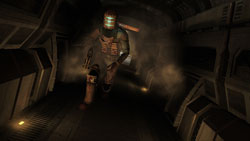 Your weaponry will consist mostly of unusual tools such as a plasma cutter. You will get a couple more standard military weapons, but ammo is nice and sparse in the game leaving you constantly hungry for more. You will also get some other engineering hardware which allows you to move things from far away, a sort of engineering telekinesis. Issac also gets to play with a stasis tool which slows down whatever object he hits with it. This can range from a fast-moving obstacle to a fast-moving tentacled infant-monster (creepy). This, coupled with your finite inventory space can lead to much pondering over what to keep with you and what to leave behind.
Your weaponry will consist mostly of unusual tools such as a plasma cutter. You will get a couple more standard military weapons, but ammo is nice and sparse in the game leaving you constantly hungry for more. You will also get some other engineering hardware which allows you to move things from far away, a sort of engineering telekinesis. Issac also gets to play with a stasis tool which slows down whatever object he hits with it. This can range from a fast-moving obstacle to a fast-moving tentacled infant-monster (creepy). This, coupled with your finite inventory space can lead to much pondering over what to keep with you and what to leave behind.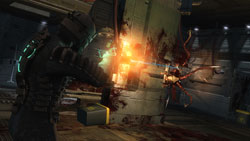 There are several other cool gameplay gimmicks in the game, even having to do with zero gravity, however I will not spoil anything more for you. Dead Space is one of those games which you just have to experience for yourself. If I can tell you one thing in this review, it is that if you usually enjoy shooters, creepy survival-horror titles, or sci-fi horror in general you will love Dead Space and should buy it right now. Go and support quality productions like this. There are far too few of them to let this one pass you by. And for goodness’ sake, try playing in the dark to start with just to get the full effect. Good luck…
There are several other cool gameplay gimmicks in the game, even having to do with zero gravity, however I will not spoil anything more for you. Dead Space is one of those games which you just have to experience for yourself. If I can tell you one thing in this review, it is that if you usually enjoy shooters, creepy survival-horror titles, or sci-fi horror in general you will love Dead Space and should buy it right now. Go and support quality productions like this. There are far too few of them to let this one pass you by. And for goodness’ sake, try playing in the dark to start with just to get the full effect. Good luck… Usually, we are nothing but excited with sandbox games. The freedom one derives from exploration can be quite liberating. In an RPG it is also equally nice to have some sort of overall quest which ties the whole thing together. TaleWorlds has decided to just keep with the sandbox part of that equation, ditching an overall quest and thrusting gamers into the unknown.
Usually, we are nothing but excited with sandbox games. The freedom one derives from exploration can be quite liberating. In an RPG it is also equally nice to have some sort of overall quest which ties the whole thing together. TaleWorlds has decided to just keep with the sandbox part of that equation, ditching an overall quest and thrusting gamers into the unknown.  The battlefield strategy employed in these large skirmishes is vital as one false swing or direction can mean the turn of the tide. Commanding troops is done easily by shouting commands at them. They are fairly basic commands but mirror what a human being would be able to shout while riding into battle. This adds an additional element of realism to the combat, as knights in the middle ages did not have GPS or other high-tech gadgets with which to organize themselves.
The battlefield strategy employed in these large skirmishes is vital as one false swing or direction can mean the turn of the tide. Commanding troops is done easily by shouting commands at them. They are fairly basic commands but mirror what a human being would be able to shout while riding into battle. This adds an additional element of realism to the combat, as knights in the middle ages did not have GPS or other high-tech gadgets with which to organize themselves. The character development is fairly complex, TaleWorlds taking a queue from Daggerfall in asking you a series of questions to determining your base character. From there, you allocate some skillpoints are off you go. Along the way you level up your character, increasing your skill points and personal wealth.
The character development is fairly complex, TaleWorlds taking a queue from Daggerfall in asking you a series of questions to determining your base character. From there, you allocate some skillpoints are off you go. Along the way you level up your character, increasing your skill points and personal wealth.